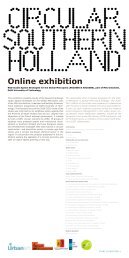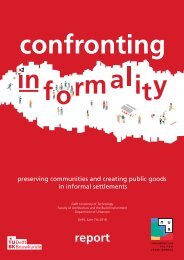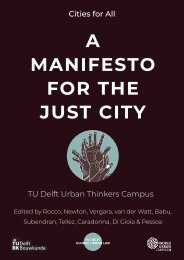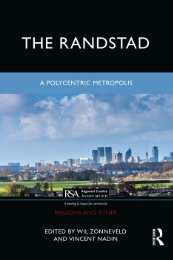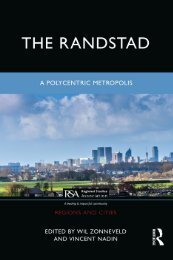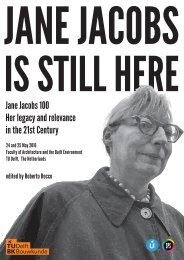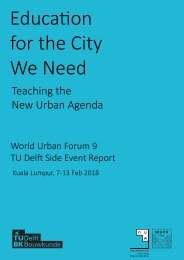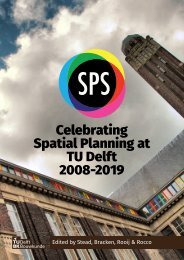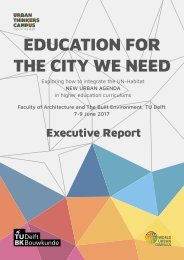The New Urban Normal Urban Sustainability and Resilience Post COVID-19
The COVID19 pandemic has exposed several systemic failures and injustices in the way cities are planned and designed around the world. It has also exposed the failings due to lack of planning in most places in the Global South. Careful, inclusive and participatory spatial planning is thought to greatly strengthen the capacity of societies to withstand systemic shocks, as testified by the New Urban Agenda (2016), the Pact of Amsterdam (2016) and the New Leipzig Charter (2020). Integrated affordable housing, for instance, has come to the top of the agenda once again, now propelled by the realisation that slum dwellers (a staggering 1 billion people around the world) and homeless people are particularly vulnerable to health crises and other societal shocks. The pandemic has been saluted as an opportunity to implement far-reaching transformation of our societies towards sustainability and justice, but little signs of systemic change have actually surfaced. For example, several cities around the world claim they will overhaul public space, take space from private cars, and invest more on green spaces, bicycle paths and quality public mobility. But little has been said about addressing the structural causes of inequality. The champions of the circular economy salute the pandemic as a new dawn for more human-centred capitalism, for the abandonment of exploitation and unfair distribution, and a world where workers can find decent housing, health, work and leisure. But what is actually happening on the ground?
The COVID19 pandemic has exposed several systemic
failures and injustices in the way cities are planned and
designed around the world. It has also exposed the failings
due to lack of planning in most places in the Global South.
Careful, inclusive and participatory spatial planning is
thought to greatly strengthen the capacity of societies to
withstand systemic shocks, as testified by the New Urban
Agenda (2016), the Pact of Amsterdam (2016) and the New
Leipzig Charter (2020). Integrated affordable housing, for
instance, has come to the top of the agenda once again,
now propelled by the realisation that slum dwellers (a
staggering 1 billion people around the world) and homeless
people are particularly vulnerable to health crises and
other societal shocks.
The pandemic has been saluted as an opportunity to
implement far-reaching transformation of our societies
towards sustainability and justice, but little signs of systemic
change have actually surfaced. For example, several cities
around the world claim they will overhaul public space,
take space from private cars, and invest more on green
spaces, bicycle paths and quality public mobility. But little
has been said about addressing the structural causes of
inequality. The champions of the circular economy salute
the pandemic as a new dawn for more human-centred
capitalism, for the abandonment of exploitation and unfair
distribution, and a world where workers can find decent
housing, health, work and leisure. But what is actually
happening on the ground?
Create successful ePaper yourself
Turn your PDF publications into a flip-book with our unique Google optimized e-Paper software.
46 <strong>The</strong> <strong>New</strong> <strong>Urban</strong> <strong>Normal</strong><br />
Roundtable Discussion<br />
Led by Moderator Costanza LaMantia<br />
For Costanza, it is important to listen to three different<br />
perspectives. <strong>The</strong> European perspective, which is about policy<br />
structure, orients the action of the member states <strong>and</strong> is very<br />
institutionally focused. And the activist perspective, which is<br />
also very important because we need to have pressure from<br />
the bottom in order for policies to be implemented. And<br />
lastly, the perspective from a think tank that has an advisory<br />
role, exploring possible futures <strong>and</strong> imagining how to turn<br />
these policies into concrete actions, from very small to bigger<br />
scales. Costanza puts a question to the representative of the<br />
European Commission, S<strong>and</strong>er: In this event today we focused<br />
quite a lot in Europe. Europe has an important role as a donor<br />
<strong>and</strong> an important actor in the international scene, so what<br />
Europe does has implications elsewhere. Hence, there is a<br />
need to be coherent also internationally.<br />
Costanza asks S<strong>and</strong>er: How is the European Union thinking<br />
[about the Green Deal] through its international grants <strong>and</strong><br />
programs <strong>and</strong> how they affect developing countries? S<strong>and</strong>er<br />
answers that this is not his area of expertise, <strong>and</strong> there are<br />
others who work with cooperation, aid, <strong>and</strong> trade.<br />
What he knows comes from being at the table when<br />
negotiations being conducted by other services of the<br />
European Commission take place. Although he agrees with<br />
Constanza’s characterization of the Green Deal for Europe as<br />
an institutional action, to help member states take decisions<br />
<strong>and</strong> formulate policies, he points out that these initiatives<br />
are often accompanied by legal dimension that is very<br />
international. And so, it is for the European Green Deal, which<br />
also has an international [legal] dimension. Europe aims to<br />
be the first climate neutral continent, but this is also because<br />
Europe wishes to show the rest of the world that it is possible<br />
MAIN TAKE AWAYS:<br />
Widened political space through activism,<br />
internationalism, European soft<br />
power, role of institutions, role of think<br />
tanks & NGOs.




